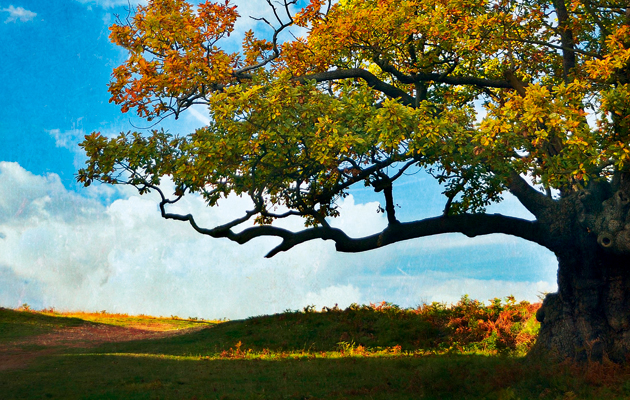Bring back Oak Apple Day
A 17th-century holiday to mark the restoration of the monarchy might no longer be widely celebrated, but it should be, urges Geoff Heath-Taylor.


Since time immemorial, the oak tree has towered in our national consciousness as a symbol of what it means to be British, an embodiment of the redoubtable spirit that enabled a small archipelago just west of mainland Europe to secure its premier position on the world’s stage. The oak tree exemplifies strength, patience and resilience, single-minded in its slow and steady goal to be the biggest, oldest and most beautiful tree in the wood.
But there is one major event in this tree’s ancient history that bestowed upon the oak its status as the tree of kings—it was in the boughs of an oak tree, a short distance away from Boscobel House in Shropshire, that a young Charles II hid from his Roundhead pursuers after the Battle of Worcester in 1651. Nine years later, the restored Charles II rode triumphantly into London on his birthday, May 29, to take his place on the throne.
Four or five generations ago, every British man, woman and child would have known the story of this turning point in our history. From 1660, the Restoration was celebrated as a national holiday, until the Victorians abolished it in 1859.
The oak became the symbol of Royalist sympathisers and, each year on May 29, known as Oak Apple Day or Royal Oak Day, it became customary for subjects to show support for their king by wearing a sprig of oak leaves or an oak apple. Some ardent Royalists even went so far as to cover their oak leaves with gold leaf.
The day was full of celebrations, with villages and communities maintaining their own individual traditions. Many of these, like other spring festivities such as May Day, had pagan roots and were rebranded after being outlawed by the Puritans. Maypole dancing, Morris dancing and feasting were commonplace. Tradition also dictated that those who didn’t wear sprigs of oak on Oak Apple Day should be thrashed with stinging nettles for being anti-Royalist or Cromwellian.
Sadly, over the past 150 years, many of the traditional Oak Apple Day celebrations have gradually been consigned to history. These festivities, and the story they mark, are all but forgotten in most parts of the country. This week, many will have no idea as to why The Royal Oak is the third most popular pub name or why multiple Royal Navy warships have been called Royal Oak. In a few places, however, commemorations continue with gusto.
Places where Oak Apple Day is still celebrated
Sign up for the Country Life Newsletter
Exquisite houses, the beauty of Nature, and how to get the most from your life, straight to your inbox.
- Historically, a member of the Royal Family visits the Royal Hospital Chelsea in London close to May 29—also the hospital’s founder’s day—to review the pensioners, who wear sprigs of oak leaves. In addition, a statue of Charles II, in Figure Court, is partly covered with oak leaves for the day. This year they will celebrate Oak Apple Day on June 4.
- In Great Wishford, Wiltshire, villagers claim their ancient right to collect wood from Grovely Wood on Oak Apple Day. Residents take an oak bough, which is then decorated and hung from the parish church tower. In order to maintain their charter, villagers proclaim their right at a ceremony in Salisbury Cathedral in which they repeat the refrain: ‘Grovely, Grovely and all Grovely.’ Although the charter requires just three ‘Grovelys’, there are usually four—‘Three for the charter and one for us’.
- In the Peak District, Castleton Garland Day, held on May 29, sees the Garland King (a Jack in the Green figure) covered in flowers and leaves and led on horseback through the town, followed by maypole and Morris dancing.
- In the centre of Northampton, the statue of Charles II at All Saints’ Church is garlanded with oak leaves at noon.
- At St Neot in Cornwall, events include the mounting of an oak branch on the church tower to symbolise allegiance to the Crown.
- Upton-upon-Severn (Worcestershire), Aston on Clun (Shropshire) and Marsh Gibbon (Buckinghamshire) also mark the day.

Sweet apple recipes
Baked into pasties with cinnamon and pecans, or chopped into a walnut and manchego salad: just two of our favourite
-
 Helicopters, fridges and Gianni Agnelli: How the humble Fiat Panda became a desirable, design classic
Helicopters, fridges and Gianni Agnelli: How the humble Fiat Panda became a desirable, design classicGianni Agnelli's Fiat Panda 4x4 Trekking is currently for sale with RM Sotheby's.
By Simon Mills
-
 What's a 'wellness village' and will it tempt you back into the office?
What's a 'wellness village' and will it tempt you back into the office?The team behind London's first mixed-use ‘wellness village’ says it has the magic formula for tempting workers back into offices.
By Annunciata Elwes